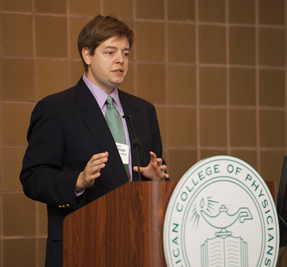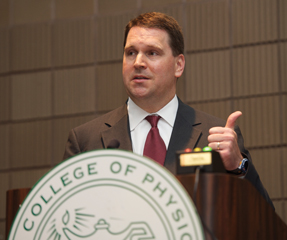‘PharManure’ and some drugs to hate the most
Drugs that made this doctor's least-most-wanted list, presented at Internal Medicine 2012, included those that increase costs without improving care, or that raise the risk of antibiotic resistance.
A lecture on newly approved medications is a common feature of medical conferences. Not as many session speakers also update you on the drugs they hate the most.
But during the “Advances in Therapy” precourse at Internal Medicine 2012, general internist Christopher L. Knight, MD, FACP, offered his perspective on both topics, as well as describing some new uses for old medications.

Drugs were likely to make his “PharManure” list if they increased health care costs without improving care. Offenders included intravenous acetaminophen, the new spray form of zolpidem, co-pay coupons for branded minocyclines, and new combinations of older drugs, such as ibuprofen/famotidine and naproxen/esomeprazole.
“Last I checked you could get a big jar of naproxen pills and a modest thing of omeprazole for less than $110/month,” said Dr. Knight, who is an associate professor of medicine at the University of Washington in Seattle.
On the other hand, some new uses that researchers have found for existing medications could prove to be cost-effective. Starting with the least expensive, a recent study found that a placebo, when dosed open label, provided slight improvement in irritable bowel syndrome (IBS). The lesson isn't that you should give all your IBS patients placebos, said Dr. Knight. “But when your patient comes in and tells you something is working, you should listen to them if it doesn't cost a thousand dollars.”
Patients might also be talking to their internists about the new indication for tadalafil (Cialis). The drug is now FDA-approved to treat benign prostate hyperplasia, based on a study that compared it to tamsulosin. “Interestingly, there was greater quality of life improvement with tadalafil,” Dr. Knight said, to laughs from the audience. This new indication may ease the pre-authorization process for the drug, he added.
Quality of life improvement was also seen in a study of selenium for treatment of Graves' orbitopathy. Based on that and reductions in eyelid aperture, the drug seems like a good option for patients with this specific condition, but not those with Graves' disease and no eye problem, or everyone in general, given other recent findings.
“This study was published a month before another study saying that selenium is a heavy metal and shouldn't be in all kinds of supplements,” said Dr. Knight.
He also gave cautionary advice about two new options for treating chronic obstructive pulmonary disease (COPD). Roflumilast is a new drug that had no effect on exacerbations in the general COPD population but reduced them by 17% in patients who typically had more than one exacerbation per year.
Side effects included depression and anxiety, so physicians should be cautious with this drug in patients who already have mood disorders. “This is not something you use in people with garden-variety COPD,” Dr. Knight said.
One garden-variety antibiotic, on the other hand, was recently found to reduce COPD exacerbations. In a trial, azithromycin provided a 35% absolute reduction in exacerbations, but individual and widespread resistance is a concern. “I just worry about putting lots of people on antibiotics for long periods of time,” Dr. Knight said.
The risk of eventual resistance is also a concern with one of the new drugs he highlighted in the talk. Ceftaroline has proven to be effective against methicillin-resistant Staphylococcus aureus (MRSA), including isolates that are resistant to vancomycin.
“I love this drug. That said, I think there are good reasons we shouldn't use it,” said Dr. Knight. “You don't use a drug that treats vancomycin-resistant bugs; you save it.”
Other drugs that he urged cautious enthusiasm about included telaprevir and boceprevir, FDA-approved for hepatitis C virus (HCV) last year. The drugs improved outcomes and appear to hold potential for short-course treatment, but even 24 weeks of therapy may be out of reach financially for many HCV patients. “You're looking at somewhere between 30 and 50 grand,” said Dr. Knight.
It's too early to guess the price on RG7128, a hepatitis C drug that doesn't even have a name yet, but Dr. Knight is excited about the medication's success at reducing viral load in treatment-naïve and non-responding patients in a recent dose-finding trial.
“I wouldn't normally report on a phase I trial,” he said. “The reason why I'm telling you about this is it's a pill. This would be huge if there were oral therapy for hepatitis C.”
Price is also a potential issue with ulipristal, an emergency contraceptive that appears to be effective in controlling bleeding in women with fibroids. And to round out the new drugs, Dr. Knight mentioned fidaxomicin for Clostridium difficile (cures about like vancomycin but costs a whole lot more) and a number of new cancer treatments that prolong survival by months but at great cost (“They are trying to come up with another magic bullet. They're not quite there,” he said).
Also not quite there, but scheduled for re-review by the FDA, is phentermine/topiramate as a treatment for obesity. It's a combination of two already existing drugs whose weight loss properties had been noted but were outweighed by side effects. Phentermine, which was one-half of the infamous fen-phen, causes hypertension and agitation, while topiramate does the opposite.
“They balanced out that feeling of logy with a little feeling of buzz,” said Dr. Knight. A trial found that the combination reduced weight and incidence of type 2 diabetes. “Is this the best way for people to lose weight? Of course not,” he said, noting that diet and exercise are preferable, but not always successful. “I am not a big fan of diet pills.”
Those who prefer their treatments in non-pill form might be pleased by a recent trial of constipation treatments. In a very small study, sponsored by the prune growers' association, prunes worked slightly better than psyllium. And the fruit treatment arm had other benefits as well, Dr. Knight noted. “Prunes are actually much more tasty than that nasty powdered stuff.”
Also of interest to elderly patients and their physicians would be new research in over-65-year-olds undergoing hip fracture repair, which found no association between opioid use or dosage and incidence of delirium. “This is something I worry about treating older patients in the hospital: Am I going to make them crazy by treating their pain?” said Dr. Knight. Based on this study, the answer is no, he concluded. “It's OK to treat pain in elderly patients.”
On the other hand, it's not OK to use dronedarone and aliskiren, at least in patients with permanent atrial fibrillation and diabetic nephropathy, respectively. Concerning new data on the effects of these drugs in patients with these conditions came out in 2011, Dr. Knight reported.
Returning to the good news, he drew attention to rifapentine, a treatment for tuberculosis. “It's not a new drug. But I had never heard of it,” he said. It's a drug that only has to be given once weekly with isoniazid for three months. This would have been much appreciated by a recent patient of Dr. Knight's who had undergone the standard treatment, nine months of daily isoniazid.
“He was miserable for the nine months. He hated taking the pills and had to stay away from his usual glass of wine,” he said.
Another drug that's definitely not new, but worth talking to your patients about, is sunscreen. An Australian study found that a five-year trial of telling people to put sunscreen on their face and hands every day resulted in reduced skin cancer even 15 years later.
“If you're in a sunny place, this is a reasonable thing to recommend to patients,” Dr. Knight said.





